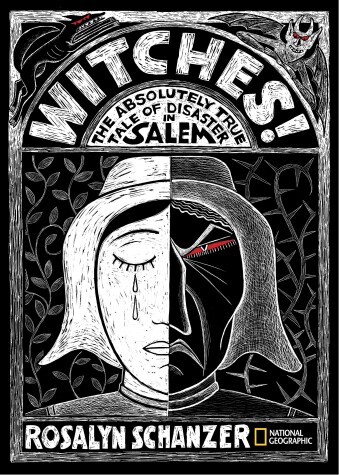Reviewed by Nicole Lynn on
Witches: The Absolutely True Tale of Disaster in Salem by Rosalyn Schanzer initially peaked my interest because I was obsessed with the Salem Witch Trials when I was younger. I remember reading a lot about the event/time period after reading A Break With Charity by Ann Rinaldi in fifth grade. I've always been fascinated with how the hysteria of that time lead to such violence and fear. What truly caused all this fear and all the accusations? How could one area, just a few young girls, and a misguided court system sentence so many innocent people to their death (or into poverty afterwards) without anyone else raising arms about what was happening? There are a lot of theories for how this tragic event occurred and of course no one can know for sure how this all happened. However, that hasn't stopped me from reading up on it and constantly being drawn to the subject.
As I said above, this title was on a list of texts that I was able to choose from to read for class. I chose this novel and M. T. Anderson's Symphony for the City of the Dead. This being the shorter of the two & on a subject that interests me greatly, I delved into it first. I picked up the book as I sat to board my flight to Buffalo, NY for a quick girls' trip with my friends to Niagara Falls. I started it right there in the terminal and finished it on my flight. It probably took an hour and a half at most to read, which for an informational text targeted to a young adult audience really knows its audience and will appeal to younger readers. I loved that the text was a quick read! Not only that, but it was immersive as well.
From the bat, the illustrations draw you in. The author notes that she "decided to do the artwork in black and white with a few small red accents" because the "tale is so very dark in tone" (144). And I have to say her decision was spot on! The artwork works so well within this text because it not only compliments the darker tone of the subject, but also draws the reader's interest by displaying non-realistic and more metaphorical images that are interpretive of the text's contents. Additionally, the artwork does a great job of breaking up the text, which to some younger readers is a must-need to keep their interest in a non-fiction work.
The writing and organization of the information was also well done. Schanzer does a great job of making this informational text read like a narrative. She also does a great job of weaving in primary sources by interjecting the text with quotes from actual court trials of some of the accused as well as quotes from various primary sources such as letters and diaries. I really enjoyed her inclusion of these quotes. It not only brought the narrative and time period to life, but it also added credence to this text as being a well researched and accurate one. I also enjoyed how she included information on some of the accused after they were released and the trials were suspended. Schanzer even includes information on what happened to some of the accusers, some of the government officials, and some of the relatives/families that lost loved ones to the trials. Let's just say that the recompense offered to some of the families who lost their loved ones was not nearly what should have been given to them.
Overall, I found this text to not only be informative and accurate, but also entertaining. The quickness of the book along with the narrative writing style and interesting artwork makes this informational text one to add to your shelves if you're at all interested in the topic! I definitely recommend it to any non-fiction lovers, especially those interested in the Salem Witch Trials. Furthermore, I'd also recommend this to young readers (Middle Grade & Young Adult) who are looking for an interesting and quick non-fiction read. Definitely one to add to your collection if you're a librarian in my opinion :)
Reading updates
- Started reading
- 21 June, 2016: Finished reading
- 21 June, 2016: Reviewed

